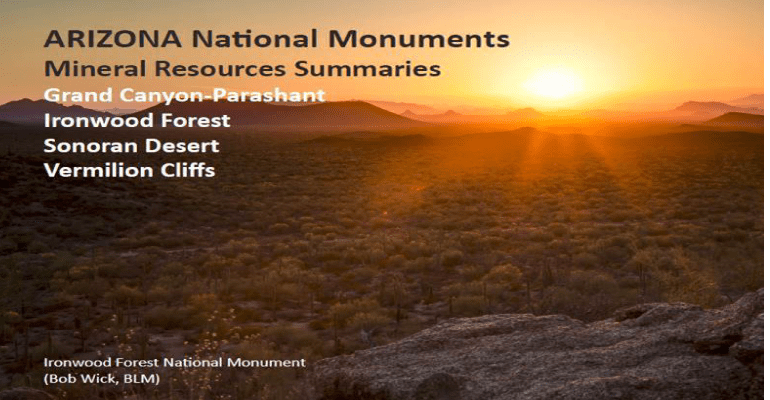
In view of President Trump’s program to reassess some National Monuments, the Arizona Geological Survey has released flyers regarding the mineral potential of four Arizona monuments: Ironwood Forest, Grand Canyon-Parashant, Sonoran Desert, and Vermilion Cliffs. You may read these short flyers here: http://repository.azgs.az.gov/uri_gin/azgs/dlio/1715
Ironwood Forest, about 35 miles northwest of Tucson, has an active copper mine and, according to local geologists, much more potential resources both east and west of the active mine. You can read about the history of the Silver Bell mine in a new paper by geologist David Briggs here: http://repository.azgs.az.gov/uri_gin/azgs/dlio/1714 Briggs notes: “Over the past 130 years, the Silver Bell mining district yielded approximately 2.27 billion pounds of copper, 6.6 million pounds of molybdenum, 3.7 million pounds of lead, 40.8 million pounds of zinc, 2,100 ounces of gold and 5.95 million ounces of silver.”
The Grand Canyon-Parashant area has produced copper, uranium, lead, zinc, gold, and Silver from breccia pipe deposits within what is now the monument. Breccia pipes are vertical pipe-like structures comprising broken rock (breccia). They are collapse features that originate in the cavernous Redwall Limestone and subsequently propagate upward through upper Paleozoic and lower Mesozoic rock formation. A recent review by the Arizona Geological Survey indicates that there could be thousands of yet unexplored breccia pipes within the monument. (See my article: Breccia pipes of northwestern Arizona and their economic significance)
The Sonoran Desert monument west of Phoenix has historically produced , gold, silver, copper, and manganese from small mines. The Aguila manganese mineral district in the Big Horn Mountains produced 42 million pounds of manganese.
The Vermilion Cliffs area in northwestern Arizona has had some small production of uranium, but the AZGS concludes “ there is little geologic evidence for economic minerals deposits in the monument.”
Two of the monuments, Ironwood Forest and Grand Canyon-Parashant, have had significant mineral production and more inferred resources. This should be taken into account in assessing their status. The imposition of National Monument designation greatly inhibits or even prevents development of valuable mineral resources.
Note to readers:
Index with links to all my ADI articles: http://wp.me/P3SUNp-1pi
My comprehensive 28-page essay on climate change: http://wp.me/P3SUNp-1bq
A shorter ADI version is at https://arizonadailyindependent.com/2013/08/01/climate-change-in-perspective/
